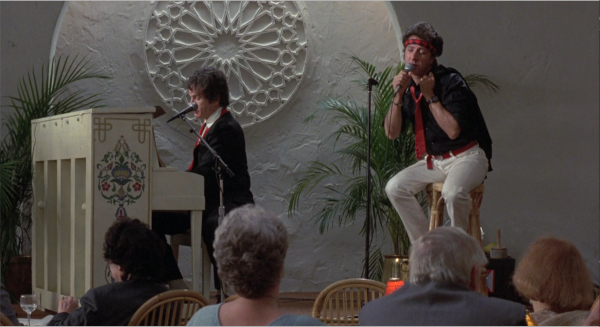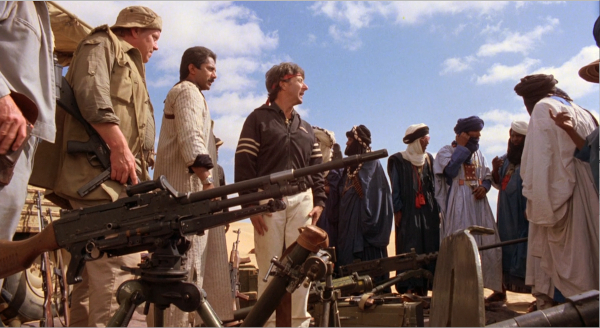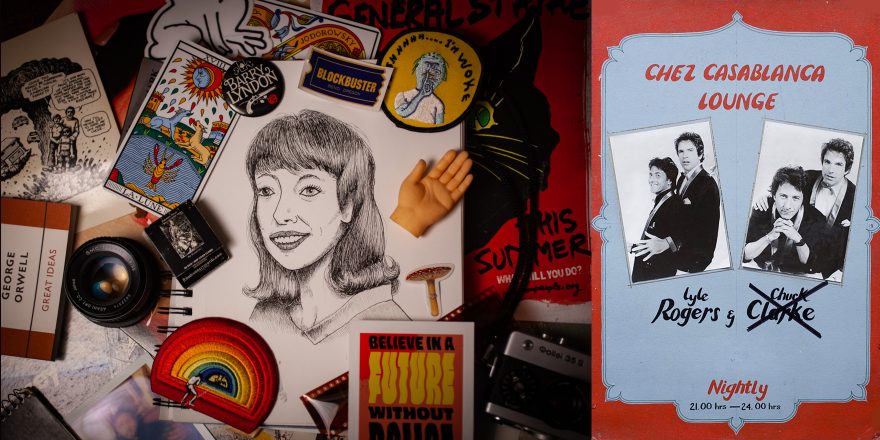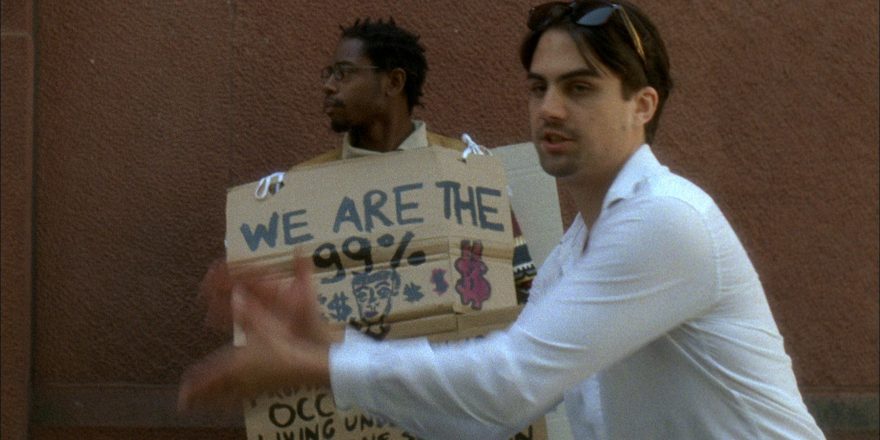When I was in high school, I was a self-proclaimed “anarchist.” I’m putting the word in quotation marks because I was still figuring out what it actually meant. I was trying to navigate the complex political world with simple anti-war slogans inspired mostly by Rage Against the Machine, Naomi Klein and Noam Chomsky. I made a DIY anarchist zine that I distributed in high school. (Printing was practically free, thanks to after-hours trips to my dad’s office.) In music and books, I could always find the radical politics I aligned with (like fuel to my suburban fire). But in film — my true passion — I was hard pressed to find anything, save for some obscure 1960s French New Wave films. The ceiling of provocation in mainstream movies was reached with Bowling for Columbine, and Michael Moore got extra credit because he had just directed the music video for Rage’s “Sleep Now in the Fire,” which transfixed me whenever I occasionally caught it on MuchMusic. It was like radicalism, comedy and Situationist performance all wrapped into one.
By then, I had become more cynical and defeated. It seemed like everywhere I looked, film was in the gradual process of deradicalization, a kind of cinematic castration. I decided the 1980s were to blame. The Back to the Future and Indiana Jones films, which I absolutely adored as a kid, were now the enemy. Key players in the demise. Entering into my late teens, I had something of an awakening while perusing the shelves of Suspect Video, a haunt on Markham St. in Toronto: I discovered the work of Elaine May. The store had a little shrined section devoted solely to her, and being the absolute contrarian I was (and still am), I had to see the film everyone told me to avoid: Ishtar.

At the time, I was working at a movie theater serving greasy popcorn to the yuppies in Yorkville, a posh pocket of downtown Toronto. When I consulted the older colleagues at the cinema about May, they steered me toward her early career films. “Stick with Mikey and Nicky or A New Leaf.” Very little was mentioned about Ishtar, but when I brought it up, there was a staunch warning of its badness. People whose taste I shared were adamant about the giant misstep Elaine May took with her last film. When I scoured for differing opinions online, the same sentiment was echoed by respected film critics. New York magazine’s David Denby, in particular, called it a “vanity production.” But Denby had also slammed Do the Right Thing for depicting a “sanitized” version of African Americans without all of the “crack addicts.” So, I thought, it’s Ishtar time.
Poised to be totally uninfluenced by any outside opinion, I watched it on my own the first time. I rented a DVD copy from Suspect Video and watched it during the day. When the credits ran, I was shocked, not by the promised badness of the film but because everyone had convinced me it was garbage. It wasn’t. It was actually quite good. I had to collect myself. “Do I like this because I was told I wouldn’t like it?” This is a question I almost always ask myself after I enjoy a film that gets panned (see: Cats). There’s no telling what my contrary nature will accept wholeheartedly just to spite public opinion. “I’ll give it a week,” I thought.

Now keep in mind, this was my first foray into Elaine May’s body of work. It was difficult to compare it to anything else, and I wasn’t well-versed enough in ’80s cinema to understand just how unlike Ishtar was from anything else from that era. Even its premise on paper seemed outlandish. It’s about two lounge-act rejects from New York, Chuck Clarke (Hoffman) and Lyle Rogers (Beatty), who venture to North Africa looking for an audience who can tolerate their terrible music. It feels like a rather bare plot until the pair ends up getting caught in a deep-state operation coordinated by the CIA. I respected the zaniness, but my admiration ended there. It didn’t read like the work of an auteur, let alone that of a dissenting one. It wasn’t until I had become a director myself and revisited Ishtar that its rebellion truly revealed itself.
By the time I was in my early twenties, Hollywood blockbusters had practically colonized the screens with militaristic, high-octane comic-book adaptions, the quaint theater I once worked at had been replaced by a Nespresso, but Ishtar was still stuck in my head, like a raspberry seed lodged in the dimple of my molar. I was starting to make my own short films with the little money I had saved, trying to find my own voice. A pattern had emerged with some directors I admired. It seemed the larger the budget of their films, the less distinctive and interesting their voices became. As a twentysomething dude living with a few punks in an anarchist DIY space on Bathurst, I chalked it up to them selling out. But Ishtar was an outlier in that philosophy: May used more money to express herself even more loudly and clearly.

As a young and still very naïve director, it became apparent to me that Ishtar was as personal a film as any of her earlier works. It displayed May’s own vulnerabilities as she ventured into enemy territory. It revealed May’s outsider status in Hollywood, an often treacherous place for female artists to work. At the time of Ishtar’s release, less than one percent of American directors were women. (That number has now marginally increased to four percent.) That May, a comedic virtuoso siloed within the industry, managed to sell a bunch of stuffy male Hollywood executives on the success of a film like Ishtar is as unlikely as it is hilarious.
I got to further understand some of what May might have had to deal with as I got more experience on sets and had the opportunity to co-direct with brilliant female directors on five different projects. I started to notice subtle things like when it came to technical questions on set, the crew would always consult me before my female counterpart. Or the not-so-subtle things like if I suggested an idea on set, it would be accepted without question. But if my co-director voiced her idea, she’d have to defend her position before people approved. These were just music videos and commercials, so I could only imagine the pushback May received on her $55 million comedy (adjusting for inflation, that price tag is around $115 million today). To put that into context, the budget was five times that of Top Gun.

Unfortunately, stories of leading man Warren Beatty and cinematographer Vittorio Storaro ganging up on May on her own film set doesn’t come as a surprise to me. When a woman is forthright in her vision, she is “inflexible”; when a man is, he is an auteur. For May, her auteurship had been under threat ever since she started directing. Her debut film, A New Leaf, was taken away from her, then she had to fight tooth and nail to regain final cut on her hugely underrated dark comedy Mikey and Nicky (1976). You can still see her brilliance shine through in those pictures. But Ishtar is Elaine May going down in a blaze of glory, an unknowing martyr for her weird and singular vision. Though May and her film were derided and attacked by both the public and the industry, Ishtar works perfectly as a countercultural statement. It feels like a big, funny “fuck you” to the establishment that tried to keep her down the same way imperialist military establishments try to keep down more vulnerable countries.
Ishtar mocks the war in the same way it mocks the dumbed-down sensibilities of the audience. May emasculates her two leading men. They’re painfully impotent as they get embroiled in the covert CIA operation. Warren Beatty, whose sexual charisma is usually front and center, hides it behind a keffiyeh for half the film. On top of that, Ishtar doesn’t exactly romanticize the glory of combat. In fact, it refuses to ever show the stirring action sequences of your typical war film. Instead you have to listen to these two terrible lounge singers perform grotesque pop/jazz songs throughout the entire first act.

There’s a reason why they never released a soundtrack of Ishtar. Bear in mind this was the same decade when films were made for soundtracks, like an accompanying toy in a Happy Meal. You liked Purple Rain? See the movie! You liked Dirty Dancing? Buy the album! Not Ishtar. The musical tie-in, like the CIA operation, becomes a farce. In the headline of a Los Angeles Times article, Paul Williams’ Ishtar soundtrack was described as “unmusic to the ear.” This was a far cry from the composer’s inspired debut for Brian De Palma’s Phantom of the Paradise (1974). But I like that the music is knowingly horrendous. The whole commodified package of a movie that became standard in the studio system needed to be mocked. Audiences sometimes need to be mocked too, lest we take ourselves too seriously.
Whenever I begin to take myself too seriously, railing against my struggles to get a film made, I think about Ishtar and find comedic relief in the fact what Elaine May achieved with it, despite everything. Even though the film bombed, it offered some glimmer of hope to those willing to ascend through the system, without losing their integrity. You can be personal and political. In fact, the two are inseparable. Perhaps that’s why many films feel impersonal now, and less dangerous. May had the ability to be politically charged and funny. And she was right to be paranoid about a system trying to derail her vision. It’s not some giant conspiracy. It’s in the subtly and not-so-subtly oppressive moments – whether it’s an established actor questioning her authority on set or the onslaught of criticism she received for questioning authority in the first place – that make the four walls slowly close in on you. All you can do is push back.

Here was an example of an artist willing to work within the system, even after it betrayed her. I think part of Ishtar’s success is in the pressure May felt from all sides. I don’t think she could have gone into the far reaches of the deserts of Morocco if she hadn’t been an outsider. It’s what happens when you push someone hard enough. How far can a system push someone until they take that system’s money to North Africa and make a musical about bad lounge acts stuck in a CIA operation? Ishtar is like the best political and financial revenge against the studio system ever.
Now that I’m a little older, I look at Ishtar as a rare example of daring personal success and sacrifice. It’s May, despite opposition, remaining steadfast in her vision in the face of a system that pretended to treat her well. It’s a haunting reminder to me that punk is not dead, it’s just looking for a second chance. It’d be awesome to see her get that second chance with Crackpot, a film announced in late 2019 with May directing and Dakota Johnson slated to play the lead. But who knows if that project will ever see the light of day.

Ishtar is still reviled by some of my close friends. And, actually, I was hesitant to add to the more recent praise of the film because part of my enjoyment of Ishtar still resides in the idea that no one else likes it. I’m in a precarious position of heralding this black sheep, yet still keeping it covered in soot, long enough that I can continue listening to Dangerous Business on YouTube and unabashedly celebrate the film and the song (these are my people). It makes me feel a bit like an outsider, a kindred spirit to May. So for the first time, I’m shedding my contrarian skin and siding with the critical consensus. Please, don’t watch Ishtar.







